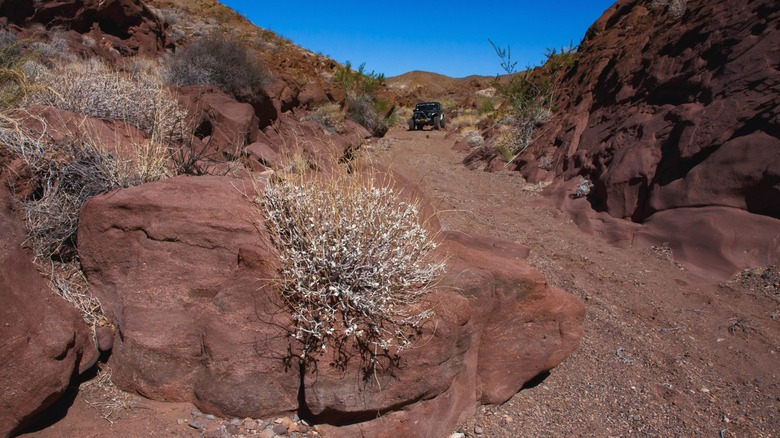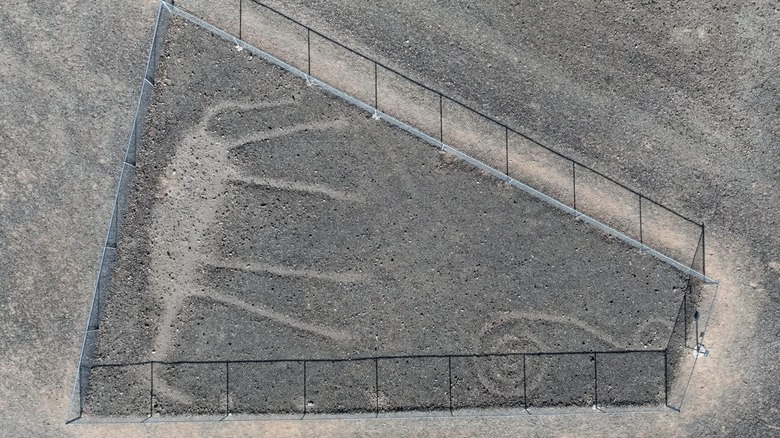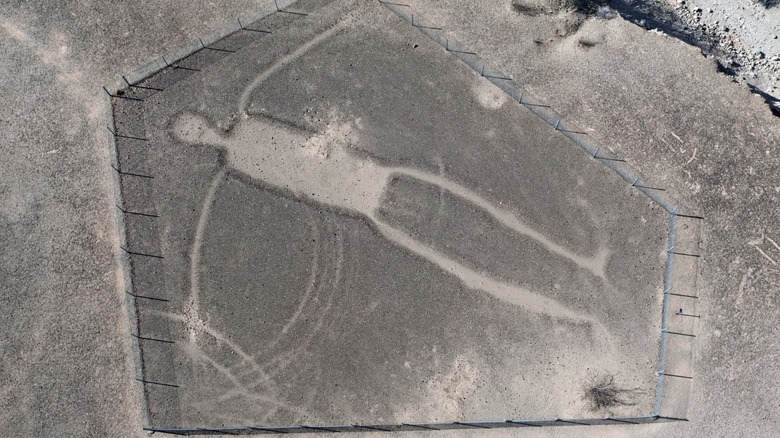California's Answer To Peru's Iconic Nazca Lines Is A Mysterious Ancient Site Etched Into Earth
From the ancient pyramids in Egypt to the grand stone heads of Easter Island to the Stonehenge boulders in England, these mysterious places around the globe often present more questions than answers. They capture the imagination as we try to fathom how these monuments and works of art were made and what they must have meant to the people who created them. The Blythe Intaglios – a group of ancient geoglyphs etched into the Colorado desert around 15 miles north of Blythe, California — present a similar mystery. Like Ireland's impressive answer to the pyramids, the Blythe Intaglios square up to the Nazca Lines in Peru.
There are only five figures at the Blythe site, in comparison with the more than 700 that exist in Peru, but they are impressive in their own right. The drawings are likely more than 1000 years old, the largest of which spans 171 feet long. According to the oral history of Mojave and Quechan indigenous people, some clarity has been reached regarding what the figures mean. Mastamho, the creator of all life, is thought to be shown in the three human figures. Hatakulya, a mountain lion/person who assisted in the creation story, is said to be represented by the two animal depictions.
The mystery of the Blythe Intaglios
Surprisingly, there are over 200 geoglyphs scattered around the Colorado Desert, such as Topock Maze and the Mule Canyon Geoglyphs. Like the many ancient petroglyphs that dot the American landscape, a visit to these intaglios in the quiet desert offers an awe-inspiring locale to view ancient art. Archeologists and scientists have been investigating the Blythe Intaglios since they were re-discovered by a pilot named George Palmer, who caught sight of them while flying over the desert in 1932, but they haven't been claimed by or attributed to any one culture.
What's also curious is that the etchings have been dated to two different times — 900 BCE and 1200 BCE — which means they were made by generations at least 300 years apart. However, historians speculate that at one point, the site must have been used religiously by indigenous groups, due to large circular imprints near the intaglios, which are attributed to many people dancing in circles.
An approach to the site offers an up-close look at the ancient methodology used to create these magnificent works of art. It's almost unfathomable to imagine the painstaking patience it must have taken to fashion the giant etchings, which involved removing the outermost layer of darkly colored soil to expose the lighter-colored dirt underneath.
Getting to the Blythe Intaglios and navigating the area
The Blythe Intaglios are accessible off US Route 95, about a 20-minute drive from Blythe, California. A stone historical monument marks the trailhead on the east side of the road, which leads you on a dirt road going west to a parking area. From there, a two-minute walk gets you to the closest intaglio, a 102-foot figure that is believed to be male due to the phallic-like shape in its center. Adjacent to that is a 60-foot animal figure that is debated to be either a mountain lion or a horse (though a horse shape would indicate that it was created much more recently) and a spiral shape thought to be a serpent.
The second closest intaglio to the road is a short drive west of the first glyph, but be advised that the road there is a bit rougher. There, you can see another person-shaped figure, which is 105 feet tall and also the best-preserved glyph.
The rugged terrain on the way to the third site dictates that you'll have to off-road to reach it, but you can also walk the distance — it is about a half-mile walk. It will be worth the effort, as this is where you'll find the tallest human figure, which is also accompanied by a 65-foot animal figure. Sadly, some of the glyphs have been partly defaced by vehicle tracks and newer attempts at creating an intaglio, but fences have been erected around each formation to prevent further damage or vandalism.


